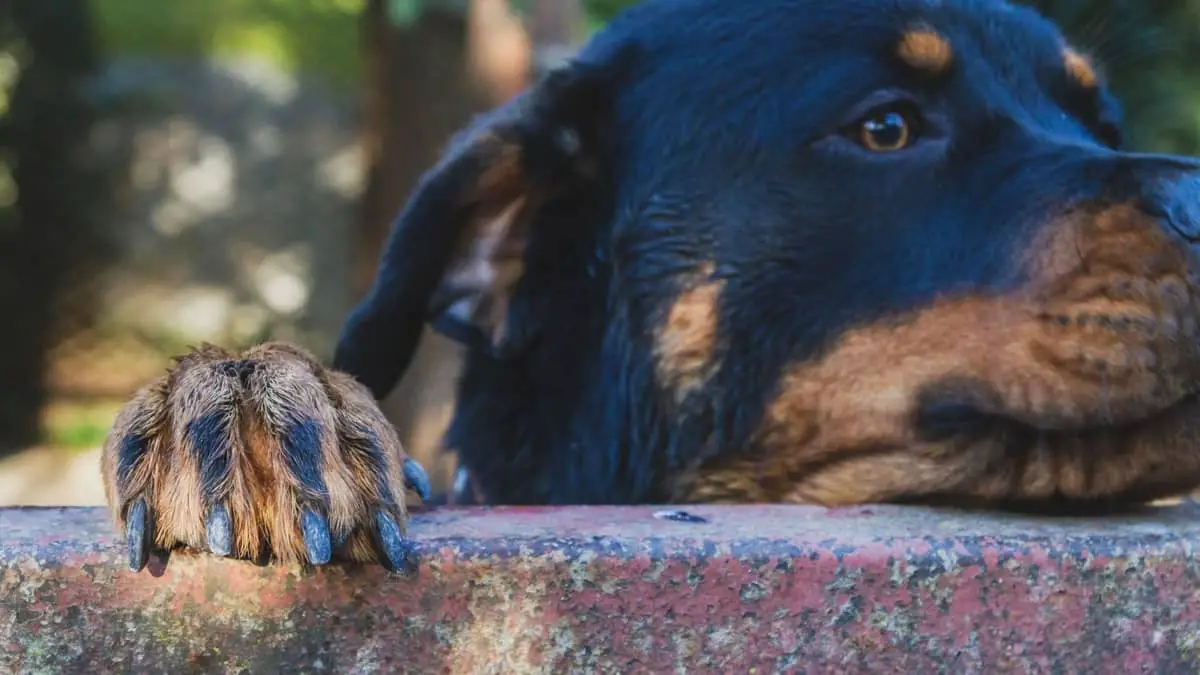Last Updated on October 10, 2021 by
Do you know what is a dewclaw and where it is found in your dog? Many pet owners have no idea what it is; let’s learn a thing or two about it.
Take a careful look at your dog’s feet; how many toenails can you see? Most dogs have 4 nails on each rear foot and 5 on the front. That extra nail on the upper, inner side of a dog’s foot is the dewclaw. If your dog has double dewclaws on its feet, do not worry. Read on to learn if your dog’s dewclaw is a problem and what you can do about it.
Table of Contents
So What Is A Dewclaw?
Dewclaws are simply big thumbs or toes of the dog world. All dogs are born with this feature, but they are not related to the human structures, but they are similar.
When you look keenly at a dog’s front toes that are in contact with the ground while standing, they correspond to our pinky, index finger, ring finger, and middle finger. The dewclaw is the dog’s thumb. The same is similar for the canine hindfoot.
The most crucial element to check is whether the dewclaws are firmly attached to the dog’s foot. Generally, if your dog has a single front dewclaw, it will be attached to the foot.
Double and Rear dewclaws are only attached by the skin and are more movable. If you try to move it, you will wiggle it a little bit – forward and backward motion while feeling the bones that connect to the leg. These bones or tendons that relate to the portion suggest that the front dewclaw has a function. Removing the front dewclaw could have lifelong consequences.
Learn more about: Why are Rottweiler Tails Docked? You Might Be Surprised
Why Do Dogs Have Dewclaw?
Some breeds like the Briards, Great Pyrenees, and Saint Bernard are born with dewclaws on all 4 legs or double dewclaws on the rear leg. Some breeders believe that the presence of rear dewclaws on the Great Pyrenees breed was purposely bred to give this dog better stability when working on rough terrain and snow.
However, in most breeds, the rear dewclaw is rare to find and often non-functional, meaning that there is no tendon attached. To know if it’s not connected, the rear dewclaws will be able to move more freely when you touch it.
The Function Of Front Dewclaws
Now that we know what dewclaws are let’s look at their functions.
When you look keenly at a dog’s foot, you will notice there are 5 tendons attached to the dewclaw. These tendons all play an important role in helping the dog move around. Here are the functions they serve
- Stabilizes the dog’s carpus when its leg is on the ground during a gallop.
- It supports the structures of the limb and prevents torque when the dog makes a turn.
- It helps the dog climb trees and climb out of water or hold items as they chew.
If a dog does not have dewclaws, there is a likelihood that the carpal ligaments stretch and tears resulting in laxity and arthritis over time. This results in more stress being generated through the dog’s carpus, shoulder, elbow, and spine, compensating for the lack of this part.
Why Do Some Remove The Front Dewclaw?
Dewclaw removal is a common practice among dog breeders and owners. But, most people still wonder if it’s necessary to remove it or not.
There are several reasons why someone may choose to remove the front dewclaws from their dog. Some breeders may choose to remove the dewclaws of 3-5 day old puppies later in life.
Let’s say this choice is very personal and varies between dog breeds, owners, breeders, and veterinarians. So, what are some of the reasons for its removal?
Some people believe that the front dewclaws are non-functional parts that are not valid. For many decades, most people thought it must not have a real purpose just because this nail doesn’t touch the ground while the dog is standing. Therefore, removal of the nail was thought not to impact the dog in any way.
Some breeders fear that pet owners won’t cut dewclaws later in life or miss them when grooming risking the nail ripping or becoming embedded.
Some people want a cleaner front look and think that removing this nail will clean things up.
Due to risks of injury and fear of the dog ripping others and humans with their dewclaw, some owners or breeders think it’s an unnecessary risk and remove the nail to prevent injury.
So, Should Dewclaws Be Removed?
We will dive straight to the point-
Because the front dewclaws serve an essential purpose, they SHOULD NOT BE REMOVED.
If the dog develops a disease or a tumor on the dewclaw, then and only then should it be removed. This happens in sporadic cases, though. Veterinarians will mainly remove the loosely attached rear or double dewclaws to prevent injury.
That said, some breeds of dogs have their dewclaws removed to make them look better in the show ring. If you choose to have this procedure performed, it should be done when a puppy is under 5 days of age. This process must be numbed using a local anesthetic.
If you remove dewclaws in breeds like the Great Pyrenees, they automatically become disqualified from the show ring.
Treating Dewclaw Injury
It is rare to find a declaw injured, but it occurs. Any nail can be split, infected, ingrown, etc., significantly if not correctly trimmed. Since these injuries are very painful and prone to infections, it’s best to have a vet assess them.
The vet can remove the damaged nail or trim the ingrown ones under sedation and prescribe any antibiotics required and pain killers.
How To Keep Dewclaws
Maintaining dewclaws is not any different from the other dog’s nails. Dogs are active, and they wear down their nails. The dewclaws also are worn out as other nails to the point that the trims are not necessary.
Regular trimming is required to keep these nails all clean and healthy. Keep an eye on the dewclaw and trim it as often as needed.
Final Thoughts
We have a better understanding of what is a dewclaw and the dos and don’ts concerning this nail. You are now wiser on how to handle your pet.




